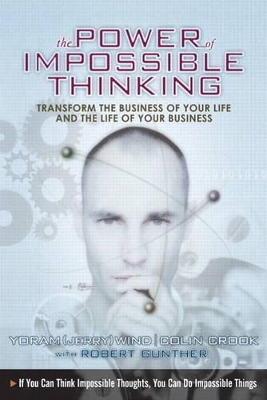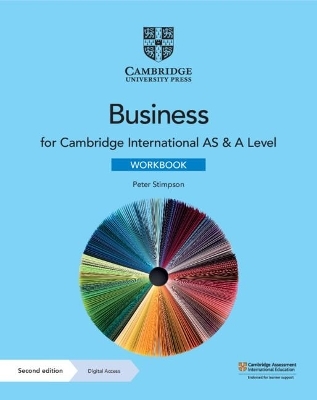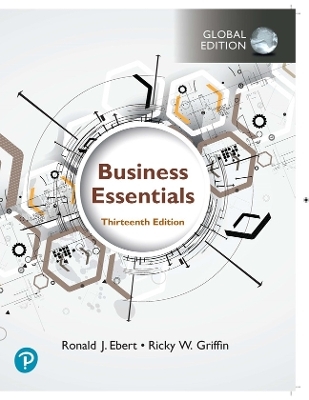
The Power of Impossible Thinking
Financial Times Prentice Hall
978-0-13-142502-6 (ISBN)
- Titel ist leider vergriffen;
keine Neuauflage - Artikel merken
This book is about getting better at making sense of the world...so you can make decisions that respond to reality, not some obsolete model of reality.
Drawing on the latest neuroscientific research and their experience with corporate transformations, Jerry Wind and Colin Crook explain how your mental models stand between you and reality, distorting all your perceptions...and how they create both limits and opportunities.
You'll learn how to develop new ways of seeing...how to keep your mental models fresh and relevant...when to change to a new model...how to build a portfolio of models...and improving your models through constant experimentation.
Better mental models = smarter decisions
Understand what's real, so you can act on it
How people get "stuck," and what to do about it
How obsolete mental models keep you from making changes
The neuroscience of mental models
What scientists can teach us about perception–and reality
Creating new models
Practical ways to see things in new ways–fast
"Wind and Crook have written a marvelous book that can teach you how to think more effectively in personal and business settings. Read it and learn!"
Drea Zigarmi
Author of The Leader Inside: Learning Enough About Yourself To Lead Others and co-author of Leadership and the One Minute Manager"We like to say, 'See it with your mind's eye.' Wind and Crook show us that our mind is our eye. What we think is what we see, and what we see directs how we act. Not only do the authors make this paradigm clear, but they offer concrete and practical ways to change our mind's eye and as a consequence change our actions and the results we get. The value of that is hard to top."
J. Stewart Black, Ph.D.
co-author of Leading Strategic Change
and Professor, University of Michigan Business School"I have been trying to explain why Japan has fallen into a pitfall and cannot come out of even the simplest problems. One can call it an innovators dilemma, but that does not solve the problem. This book suggests we have to go back to the basics of reviewing our underlying 'mental models' now and then, and only then, have to construct a new model, perhaps plural, and move onto exploring the new terrain."
Kenichi Ohmae
Author of the international bestseller, The Borderless World"While most of us may recognize that the world we respond to is more in our mind than in any physical reality, often we don't have a clue why this is so. This very important book clearly explains how our mental models work to construct these distinct inner worlds. And more importantly it offers empowering advice on how we can use this knowledge to work for us rather than against us in creating a better outer world for ourselves, our organizations, and our societies."
Charles C. Manz
Best-selling author of SuperLeadership, Fit to Lead, and Temporary Sanity"This is an important book that 'makes sense of how we make sense.' The authors provide a thorough, fresh, and compelling exploration into the dimensions of mental models. All leaders who want to be more effective in their actions would be served well to leverage the principles in this book to learn about how they think and make sense of the world around them."
Nick Pudar
Director of Strategic Initiatives, General Motors
Yoram (Jerry) Wind is The Lauder Professor, Professor of Marketing, Founding Editor of Wharton School Publishing, and Academic Director of The Wharton Fellows Network at the University of Pennsylvania. He is also the Founder and Director of the SEI Center for Advanced Studies in Management, The Wharton School's think tank. Wind led the development of a number of key Wharton programs including the reinvention of the Wharton MBA curriculum and the creation of the Wharton Executive MBA Program. Among his many affiliations is former chancellor, the International Academy of Management (IAM). One of the world's most cited marketing authors, his books include Driving Change: How the Best Companies Are Preparing for the 21st Century, and The Power of Impossible Thinking. Dr. Wind has served as an advisor to many Fortune 500 firms and non-U.S. multinationals throughout the financial services, pharmaceuticals, information, and consumer packaged goods industries, and as advisor and board member for a wide range of entrepreneurial ventures. His consulting focuses on global corporate and business strategy, corporate transformation, marketing strategy, and especially new business development. He is the recipient of all the major marketing awards. Wind received a Ph.D. from Stanford University. Colin Crook is senior fellow of The Wharton School of the University of Pennsylvania, Advisory Board member of Rein Capital, editorial board member of the journal Emergence and has served on numerous National Academy committees and advisory groups. He has provided advice to governments and businesses around the world, and is a Fellow of the Royal Academy of Engineering (UK). He was formerly Chief Technology Officer for Citicorp.
Preface.
Hijacking Our Minds.
Mental Models.
What We See Is What We Think.
The Importance of Mental Models.
Thinking the Impossible.
Endnotes.
I. RECOGNIZE THE POWER AND LIMITS OF MENTAL MODELS.
1. Our Models Define Our World.
Rethinking IBM's Research Model.
Compartmentalization of Business and Personal Life.
Domestic Emerging Markets.
The Parallel Universes in Our Minds.
Building Our Brains.
Where "Models" Come From.
Models for the Moment.
Avoiding Obsolescence.
The Consequences Of Models.
Endnotes.
2. Running The Miracle Mile.
Flights of Fancy.
Shifting Models.
Models That Are Out of Sync with the Times.
The Power Of Models.
Perils Of Models.
Changing the Tune.
Making a Segway: The Bumpy Ride to a New Model.
The Human Spirit Is Indomitable.
Endnotes.
II. KEEPING YOUR MODELS RELEVANT.
3. Should You Change Horses?
Place Your Bets.
A Wild Ride.
Knowing When To Switch Horses.
Off To The Races.
Endnotes.
4. Paradigm Shifts Are a Two-Way Street.
SOMETHING OLD, SOMETHING NEW.
THE SEQUENCE OF SCIENTIFIC REVOLUTIONS.
SOMETIMES WE GO ONLY ONE WAY.
The Paradigm Swing: Living in St. Petersburg.
Paradigms Whose Time Has Not Yet Come.
Seeing in Both Directions.
Endnotes.
5. Seeing A New Way of Seeing.
How To See Differently.
New Maps.
Endnotes.
6. Sift For Sense from Streams of Complexity.
What Is Knowledge?
Throwing a Drowning Man Another Megabyte Of Data.
Knowing More, Knowing Less.
Swallowing the Sea.
It's All about Context.
Zooming In and Out.
The Process of Zooming in and Zooming Out.
Knowing Where You Stand.
Zooming In.
Zooming Out.
Extreme Thinking: Simultaneous Zooming In and Out.
An Application: Do You Want Fries with That?
Zooming.
Endnotes.
7. Engage in R&D of the Mind.
The Need for Experiments.
Conducting Cognitive R&D.
Making a Leap.
Challenges of Experimentation.
When to Experiment: Weighing the Costs and Returns of Cognitive R&D.
Into the Laboratory.
Life as a Laboratory: Continuous Adaptive Experimentation.
Endnotes.
III. TRANSFORM YOUR WORLD.
8. Dismantle the Old Order.
Persistence of Models.
Changing Models: Revolution or Evolution.
Smoothing the Way to a New Order.
Castles in the Air.
Endnotes.
9. Find Common Ground to Bridge Adaptive Disconnects.
Adaptive Disconnects.
The Need for Unlearning.
Addressing Adaptive Disconnects.
Recognizing Your Own Adaptive Disconnects.
Bridging the Gaps.
A Process for Connecting.
Adapting the World.
Endnote.
IV. ACT QUICKLY AND EFFECTIVELY.
10. Develop the Intuition to Act Quickly.
What Is Intuition?
Instinct, Insight and Intuition.
The Power of Creative Leaps.
Dangers of Intuition.
Developing Your Capacity for Intuition.
Models in Action.
Endnotes.
11. The Power to Do the Impossible.
Howard Schultz.
Rethinking Coffee.
A Journey of Discovery and Intuition.
Bridging Adaptive Disconnects.
Building a New Order.
Zooming In and Out.
Continuous Experimentation and Challenging the Model.
Stretching Beyond the Possible.
Oprah Winfrey.
Rethinking the Talk Show.
Adaptive Experimentation: Books, Magazines and Other Media.
Bridging Adaptive Disconnects.
Build a World Order: The Harpo Infrastructure to Support the Oprah Brand.
Andy Grove.
Continuous Reinvention and Experimentation.
Changing Horses: The Strategic Inflection Point.
Using Paranoia and Cassandras to See Things Differently.
Intuition.
A Two-way Street: Adding Market Perspective to Engineering through "Intel Inside".
Conclusions.
Endnotes.
12. Challenging Your Own Thinking: Personal, Business and Society.
Healthy Thinking: Making Sense in Personal Life.
Dot-Com: Making Sense in Business.
Terrorism and Individual Rights: Making Sense in Society.
Keep Your Eye on the Model.
Endnotes.
Conclusion What You Think Is What You Do.
Beyond Possibility.
Appendix: The Neuroscience Behind Mental Models.
Core Concepts.
We Live Together in Separate Worlds.
We Use Only a Small Part of What We See.
Reality Is a Story the Brain and World Work Out Together.
Mental models.
The Cartesian Theater.
The Reality of Reality.
Explications.
Walking on a Dark City Street at Midnight (Book Opening).
Shaking Hands with Bugs Bunny: The Nature of Memory (Book Opening).
Overlooking Gorillas: Inattention Blindness (Book Opening).
Hard Wiring: Nature vs. Nurture (Chapter 1).
Seeing Things Differently (Chapter 5).
Zooming in and Out to Sift for Sense from Streams of Complexity (Chapter 6).
A Self-Reflexive World: Epistemological Solipsism (Chapter 9).
Intuition (Chapter 10).
Cultivating A Practice Of "Letting Go" (Chapter 10).
Endnotes.
Selected Bibliography.
Acknowledgments.
Index.
| Erscheint lt. Verlag | 5.8.2004 |
|---|---|
| Verlagsort | Upper Saddle River |
| Sprache | englisch |
| Maße | 159 x 236 mm |
| Gewicht | 614 g |
| Themenwelt | Wirtschaft ► Betriebswirtschaft / Management |
| ISBN-10 | 0-13-142502-1 / 0131425021 |
| ISBN-13 | 978-0-13-142502-6 / 9780131425026 |
| Zustand | Neuware |
| Haben Sie eine Frage zum Produkt? |
aus dem Bereich


